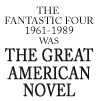







 |
 |
 |
 |
 |
 |
 |
 |
The Fantastic Four is the story of how Susan saved her family. But she was invisible in more ways than one. Susan is the star that readers readers do not see.
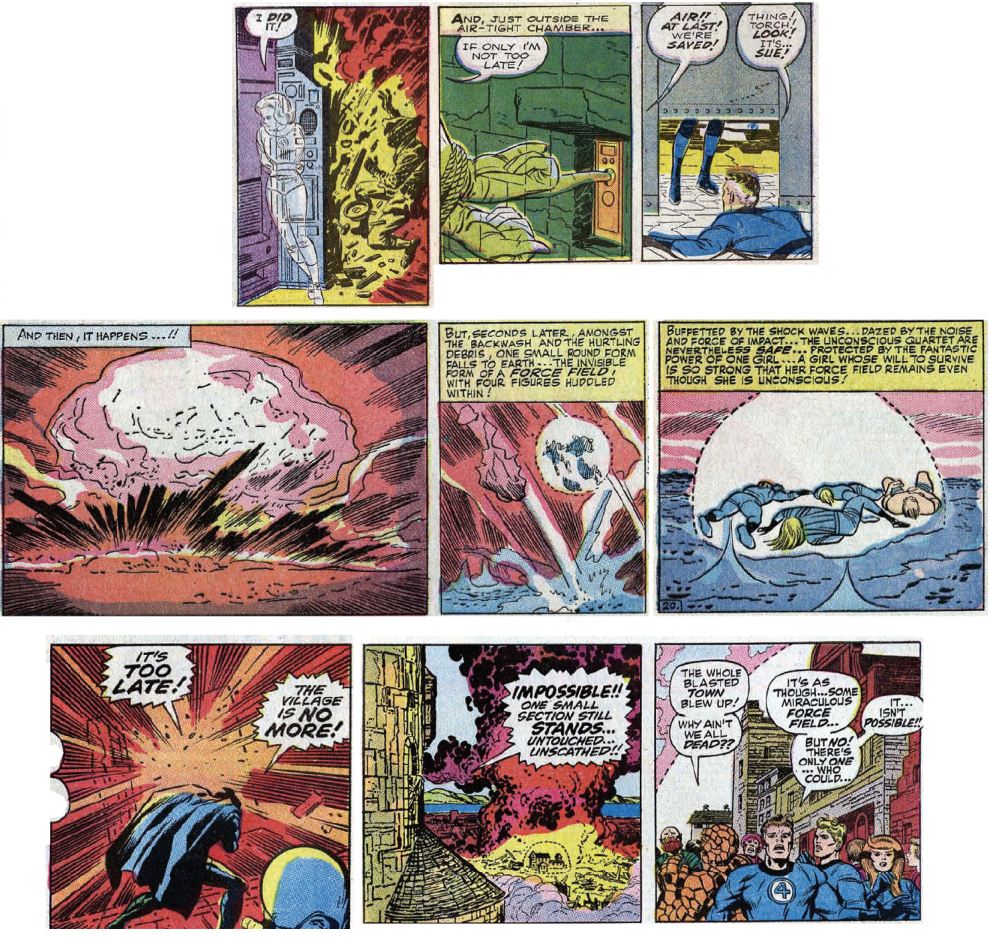
The boys' story arcs are re-active. In contrast, as the star of the novel, Sue is pro-active:
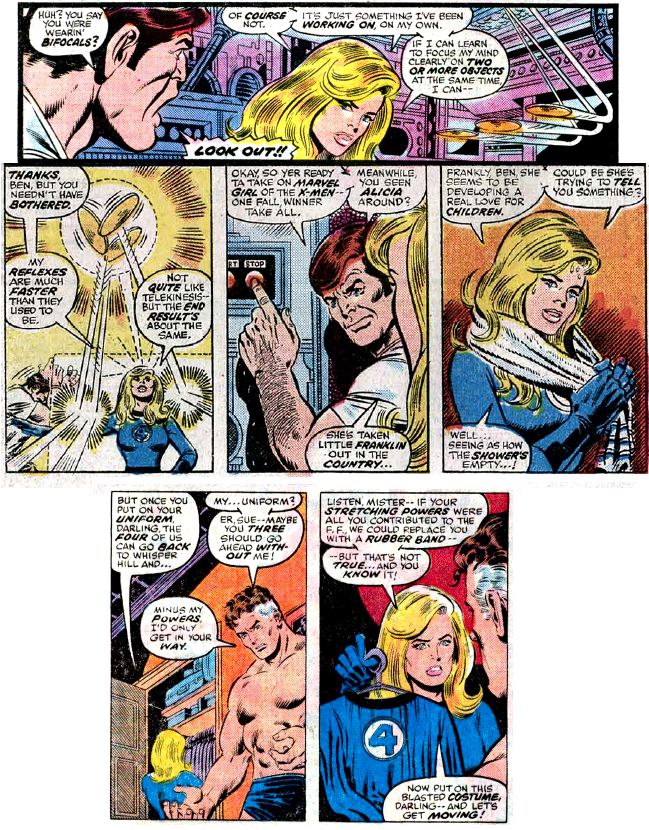
"In Marvel's greatest comics,
Lee and Kirby were full collaborators who, like Lennon and
McCartney, really were more than the sum of their parts, and
who derived their greatness from the push and pull of
incompatible visions. Kirby always wanted to drag the Four
into the Negative Zone β deeper into psychedelic science
fiction and existential alienation β while Lee resolutely
pulled them back into the morass of human lives, hormonal
alienation, teenage dating problems, pregnancy, and
unfulfilled longings to be human and normal and loved and not
to have the Baxter Building repossessed by the City of New
York. Kirby threw at the Four an endless series of ponderous
fallen gods or whole tribes and races of alienated antiheroes
with problems no mortal could credibly contemplate. Lee made
certain the Four were always answerable to the female
priorities of Sue Storm β the Invisible Girl, Reed Richards's
wife and famously 'the weakest member of the Fantastic Four'.
She wanted a home for their boy Franklin, she wanted Reed to
stay out of the Negative Zone, and she was willing to quit the
Four and quit the marriage to stand up for what she believed.
[...] If you (I mean, I) accept my premise that the mid-to-late 1960s Fantastic Four were the exemplary specimens, the Revolver and Rubber Soul and White Album of comics, and if you further grant that pulling against the tide of all of Kirby's inhuman galactacism, that whole army of aliens and gods, was one single character, our squeaky little Sue, then I wonder: Invisible Girl, the most important superhero of the Silver Age of comics?"
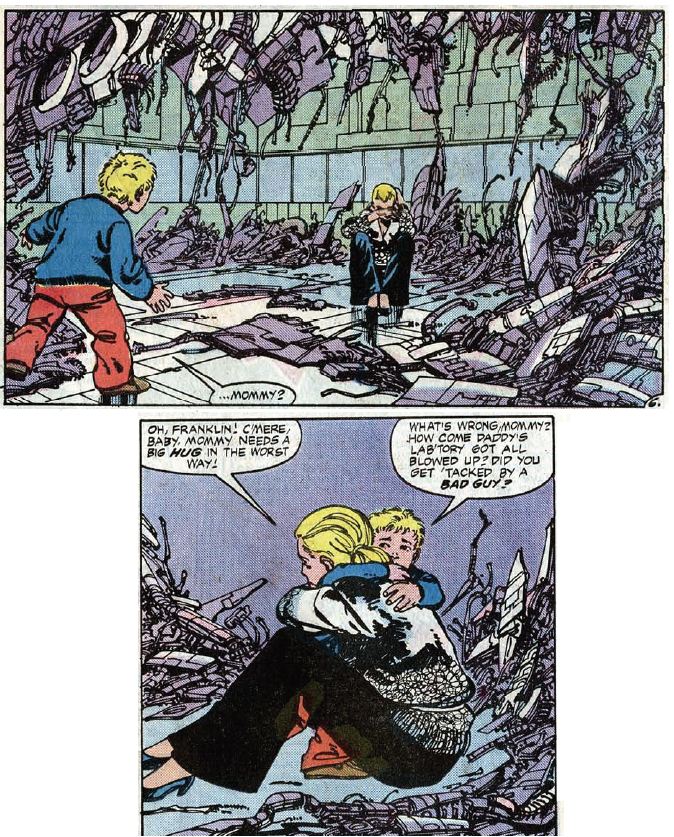
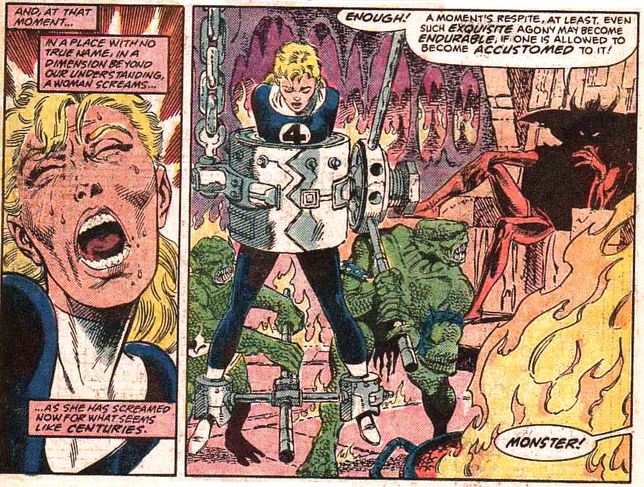
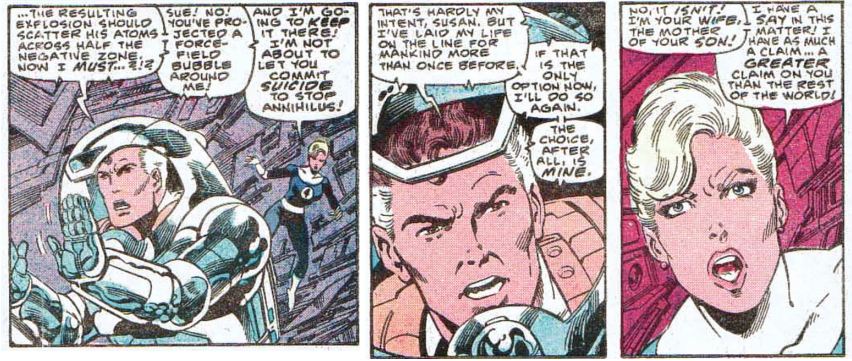
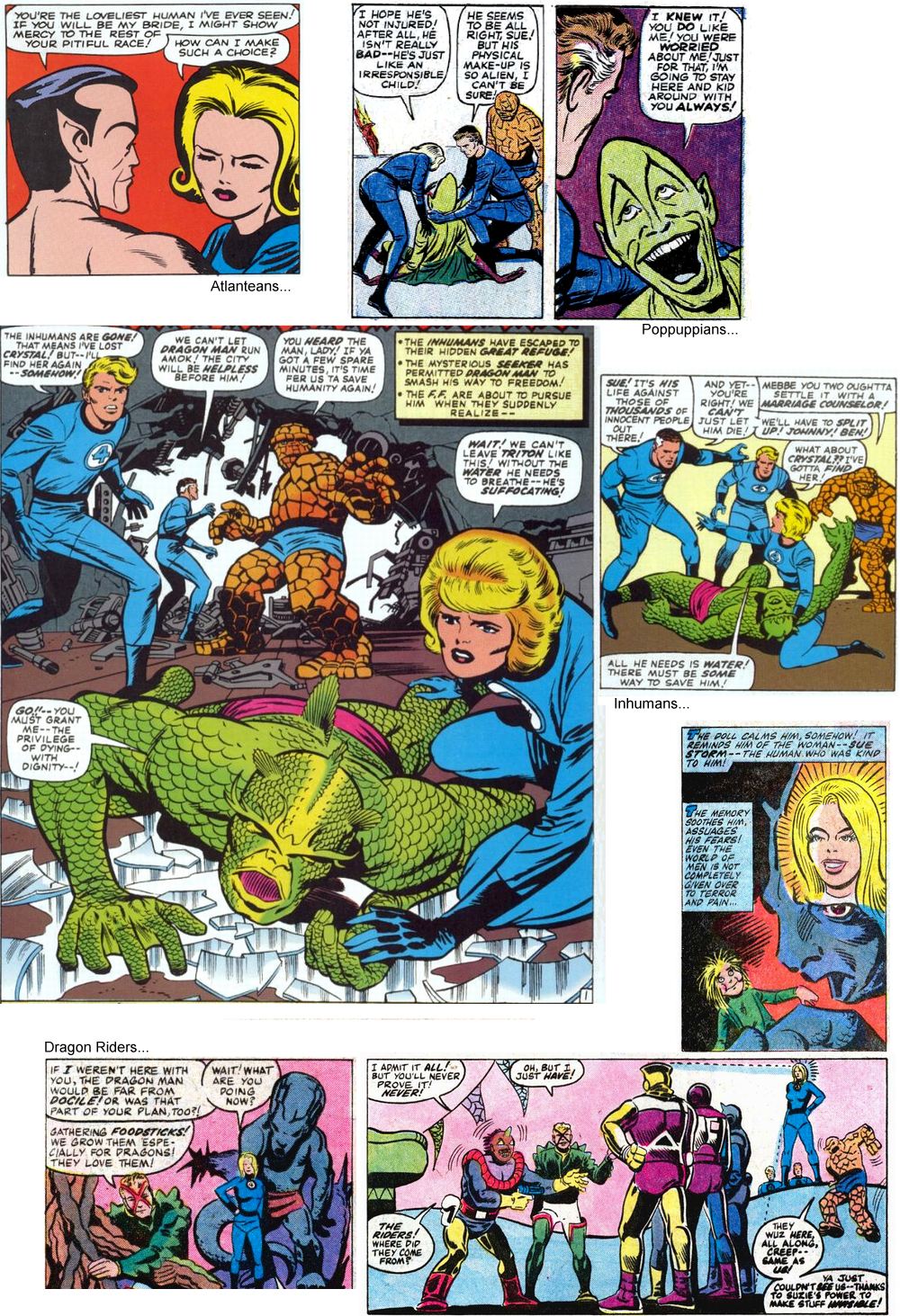
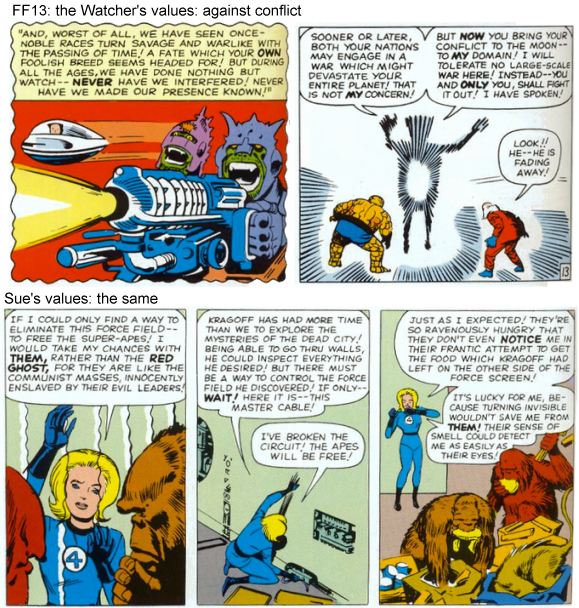
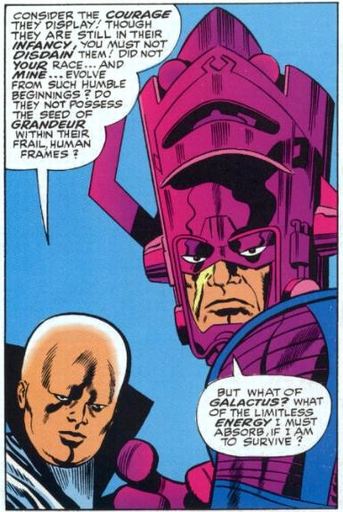
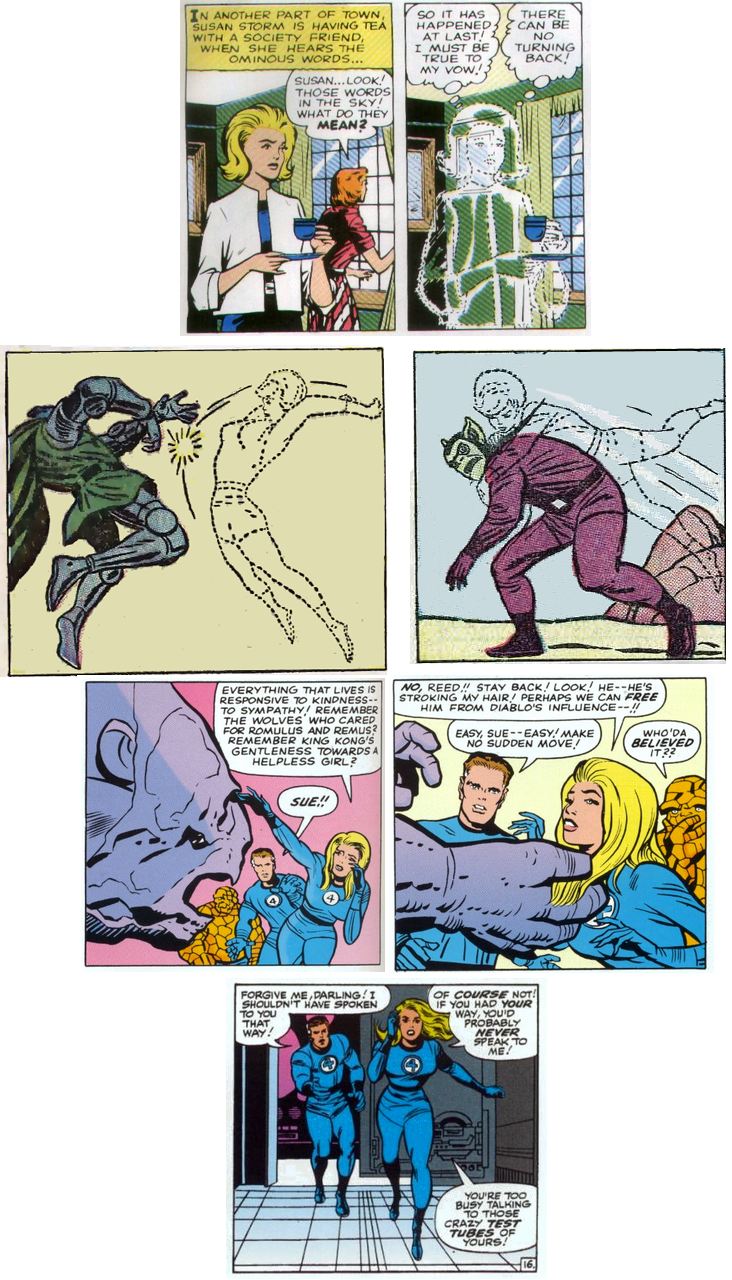
Sue is different from the boys. While they react to every crisis with "we must fight", Sue can see the bigger picture: that fighting does not solve anything. The "bad guys" always come back, and eventually this leads to everyone being dead. Instead, Sue provides alliances with powerful friends, and a son who can do anything, but the boys cannot see it.
Eventually Reed reluctantly puts Franklin first, and the rest of the team finally reach their potential. They even find that they never needed Reed's inventions: in the very first issue they could have befriended the Mole Man and gained access to his teleportation system and advanced machines, but they were held back by always treating everyone as an enemy.
In the epilogue to the story (issues 322-333 from 1990), Reed misses being in charge. He wants to come back. So at the end of the story we are offered four possible futures. The best hope is that Reed continues to listen to Sue, puts his family first, and life is good.
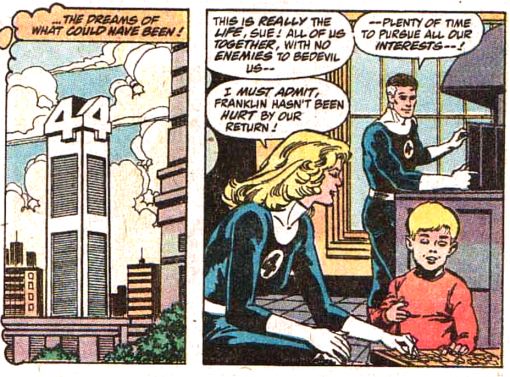
The worst of the four possible endings is that the boys return to their old ways of trying to solve every problem alone, using ever increasing violence, and end up destroying everything.
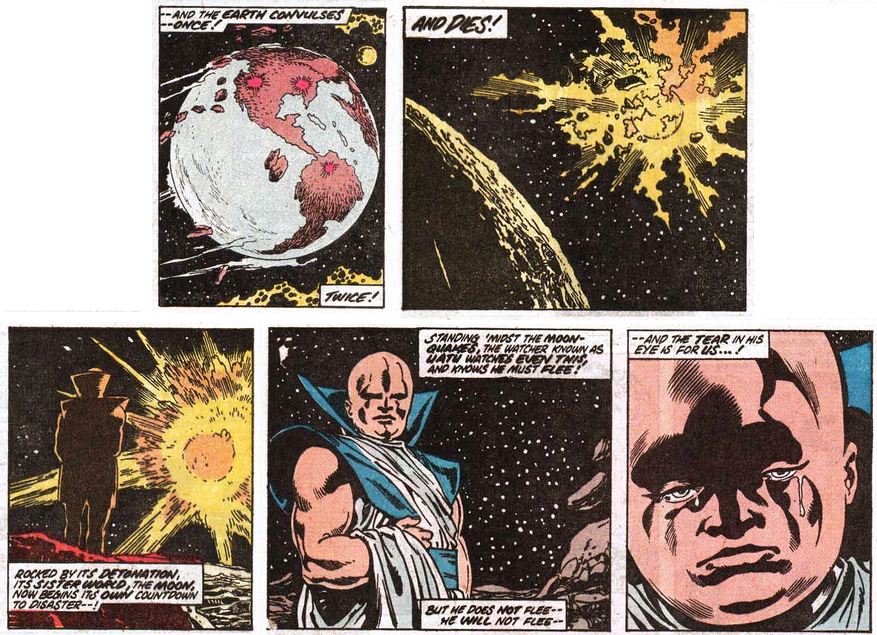
That is the family's choice. It is the world's choice. it is America's choice: peace or war. That is the message of the Great American Novel.
The story is summarised on the cover of issue 1: monsters can appear anywhere, even in the middle of a street.
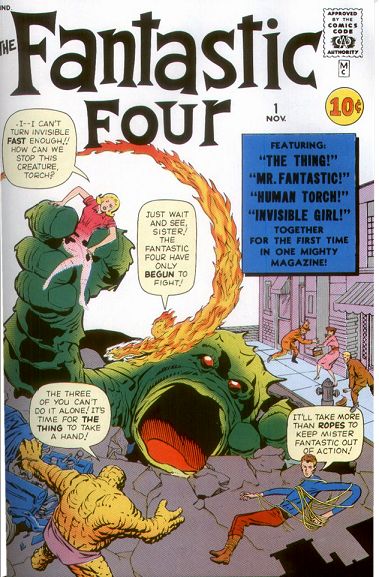
These monsters are metaphors for the dangers of nuclear war, Russians invading, hatred of people who are different, etc. Susan unites her family into a team that can defeat the monsters, and thereby help mankind.
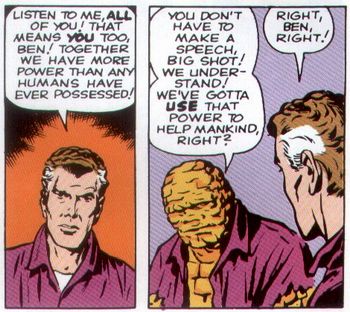
But by fighting they risk becoming monsters themselves.
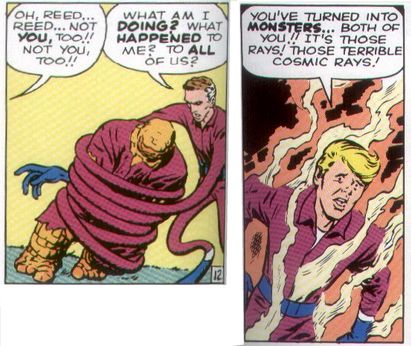
They also find that monsters have their reasons...
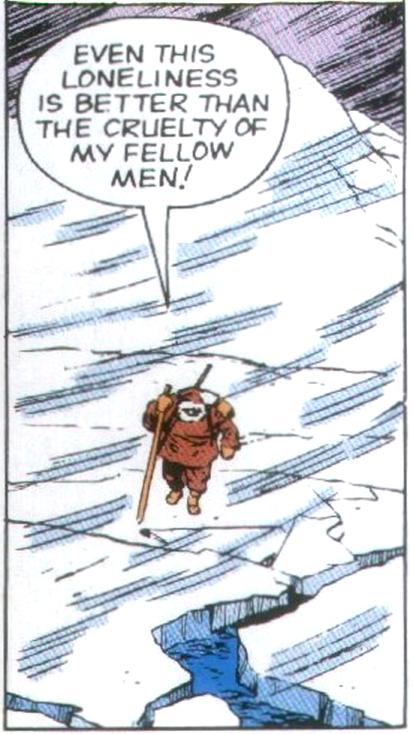
and if you defeat them they just come back.
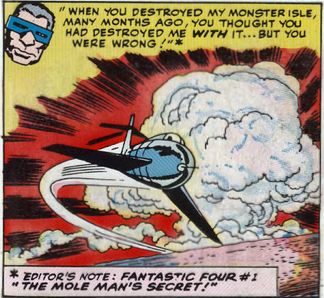
The Fantastic Four is the story of how Reed finally learned, and the monsters were finally beaten forever.
At first glance the story is about Reed Richards, humanity's greatest
hero. Reed is the smartest, the bravest (see FF 51, or Ben's comment in
FF 200), the one who creates the most amazing things. But look closer:
he only ever reacts. He sees an obvious and urgent need and tries to
solve it, but the problem always comes back. Susan,in contrast, acts.
She makes the story happen. She makes the team happen (by persuading Ben
to join, and bringing along Johnny), she saves the team (and leads the
team) when Reed fails, she judges and acts (through leaving and coming
back), and finally it is her quiet urging that changes Reed's heart and
thus defeats the monsters, both external and internal. (It is her urging
to take a break from the FF that enables Reed to come back and finally
cure Ben).
The difference between Susan and Reed is apparent in the two names. A
"reed" is something that grows quickly, but bends to every wind, but
"susan" (Hebrew for "lily") means strength, purity, and the final culmination of action.
(It also hints at a connection to wisdom and great age - Susan's age is
her great secret - see FF 291.) Similarly, while "richards" means a
strong ruler (literally "rich" and "hard"),
it implies no progress.
The name comes from a time in history when "strong rulership" meant
keeping others in their place, and thus society as a whole made little
progress.In contrast, "Storm" suggests true power: storms are just air
and tiny drops of water, yet they are more powerful than all the world:
each average storm contains 200 times the Earth's electrical generating
capacity (source).
None of what I am saying is obvious from glancing at the comic.
Readers will think I am mad. A glance at the comics makes Susan look
weak, not strong (at least until Byrne's run), and most people do not
see a climax in issue 290, or an ending in issue 333. But look closer.
When it began in 1961 the Fantastic Four was different from other
comics because the characters had memory. If they fought somebody a year
earlier, they remembered. Events had long term consequences. This was a
revolution in comic books. But still the comics had to appeal to new
readers, without confusing them. So the past can only be hinted at.
These hints are sometimes very subtle.
Not even the book's writers know the long term story: not
consciously. But they know it unconsciously. They know that the
characters would react in certain ways, even if they cannot say exactly
why: it just feels right. For example, John Byrne knew that Susan would
react extremely badly to Reed's actions in FF 290, even though, on the
surface, that made no sense. Reed had routinely put himself in danger,
so why was this different. Yet Byrne instinctively knew that this time
was very different. Some unspoken line had been crossed.
So the story is not explicitly stated. When something odd happens we
need to look for
clues. And the clues are always there. It is a case of "show, don't
tell". The comic does not say "Reed Richards will now make his second
suicide attempt, but he will deny it because he does not want to face
the truth". These characters face death every day: normally they do not
betray fear or agitation. Yet little clues reveal what is going on
beneath the surface. In this way the comic is like the book Les
Miserables. The most powerful emotions are often revealed by the tiniest
detail.
"Anyone who did not know Javert, and who had chanced to see him at the moment when he penetrated the antechamber of the infirmary, could have divined nothing of what had taken place, and would have thought his air the most ordinary in the world. He was cool, calm, grave, his gray hair was perfectly smooth upon his temples, and he had just mounted the stairs with his habitual deliberation. Any one who was thoroughly acquainted with him, and who had examined him attentively at the moment, would have shuddered. The buckle of his leather stock was under his left ear instead of at the nape of his neck. This betrayed unwonted agitation.
"Javert was a complete character, who never had a wrinkle in his duty or in his uniform; methodical with malefactors, rigid with the buttons of his coat.
"That he
should have set the buckle of his stock awry, it was indispensable that
there should have taken place in him one of those emotions which may be
designated as internal earthquakes." (Les Miserables, book 8, chapter 3)
Act 1:
the monsters
Act 1 (FF 1-5) introduces the main classes of monster: monsters from below,
from above, from the land and sea, from science, magic, and from inside: from psychology.
Act 2:
the response
In act 2 (FF 6-43) they develop the ultimate weapon, the
sub-space portal, a gateway to all possibilities.
Act 3:
the weapon
Act 3 (FF 44-102) is the classic age of the FF, the 1960s, when people thought science could protect the Earth from anything.
Act 4:
the doubts
Act 4 (FF 103-295) is when self doubt sets in. Science is not enough, as
we can do as much harm as good. Act 4 ends in Reed sacrificing himself
to destroy the
ultimate weapon, as it
is about to destroy the universe.
The Fantastic Four was a monster comic.
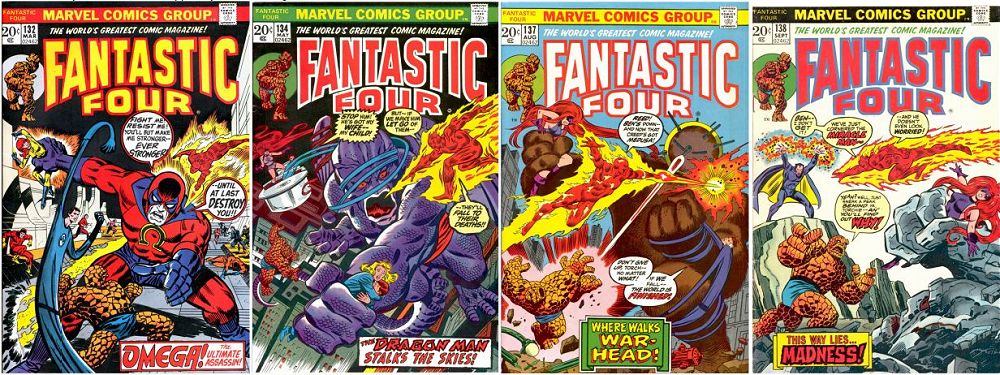
This is most obvious in the early issues, but is true throughoutact 1, issues 1-5.)
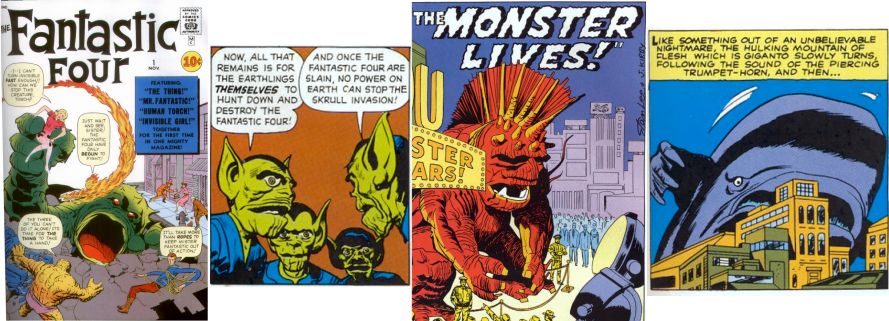
What is a monster?
Monsters are non-human (or humans who make themselves non-human), and
are so powerful that even powerful humans feel helpless. Superhero
comics are the opposite: they are about fighting other super powered
beings (usually humans), and feeling strong. This "helpless before an
alien" theme is in all the classic covers:
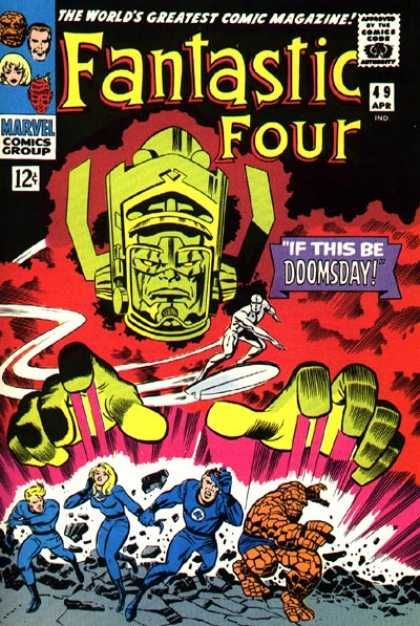
All the great Fantastic Four stories are monster stories. Take
John Byrne's run, for example. By focusing on the family he showed their
smallness and vulnerability. But when handling villains he makes them
far more powerful, and completely separated from humanity.
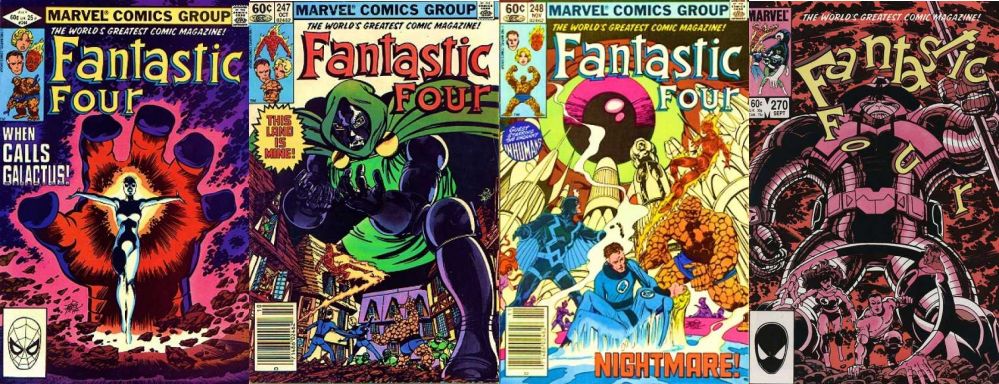
All the greatest FF adventures are against monsters. The greatest FF epic of all is against Galactus, a vastly powerful giant alien. The greatest single issue, FF51, is against the monstrous negative zone (it is alien and vastly bigger than we can ever hope to defeat: we later find it is full of conventional monsters as well). Another frequently cited classic is when Doom takes the surfer's power: in it, Doom is so powerful that nobody stands a chance, and he gains that power fro the alien Surfer. The Inhumans are literally in-human, and vastly out-gun the human race. In their first story they invite Galactus to destroy the planet, knowing they can survive and rebuild (see the notes to FF48). The smaller stories - planet X, the Impossible Man, Infant Terrible, Dragon Man, Him, various Skrull and Atlantis and Mole Man stories, etc., are against non-humans who greatly out-gun our heroes. Even the apparently human foes are monstrous: the Thinker and alien-looking Puppet Master gain their power from non-human sources, and create fake humans; the Red Ghost is backed by en entire empire and has non-human partners; the Wizard's team is only dangerous when it relies on non-humans (Medusa, Thundra), etc. While the team does sometimes meet other regular superheroes, those meetings are short and uninteresting. The only "superhero" with staying power is the Hulk, a monster.
Act 2 (FF 6-43) fills out the details in the main characters, and shows the full range of rising dangers. Each increasing danger is met by increased technology. It is building to the development of the ultimate weapon. the sub-space portal, a gateway to all possibilities. The portal is the item that links all sub-plots, and Susan is the one who must ultimately ensure it is closed.
The development of the portal.
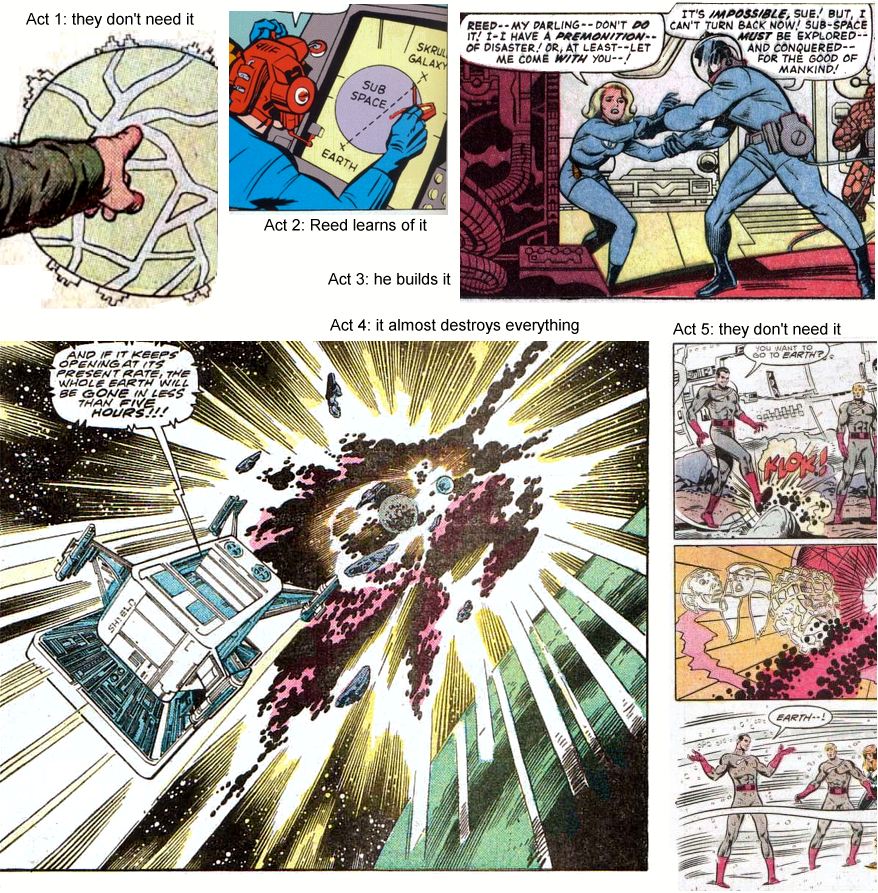
Act 3 (FF 44-102) shows the weapon in use. All the action in this period is driven by the portal. Just look at what motivates every story:
A third motive appears to be different: Reed's need to keep his
family safe. Several times
in act 3 he acts to remove Sue. But this is safe from dangers he created
by his interest in the portal, and Reed very quickly returns to
studying the portal, to Susan's great frustration.
By act 4 it becomes clear that the "technology and force" approach does not work, and is often worse than the problem. After Reed causes World War III, then empowers Janus, the Watcher says that Reed could even destroy the universe! But violence is so ingrained into humans that Reed finds it impossible to see this. Act 4 charts Reed's decline, his state of denial, and the price Sue must pay to get through to him. Reed, the world's greatest hero, becomes the monster, yet does not see it until the end.
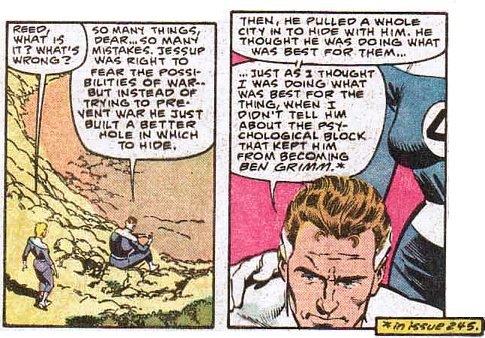
Every issue of the Fantastic Four progresses this story of Sue
fighting monsters, both literal and metaphorical. To illustrate, let's
look at Sue's final emotional battle. We
will see how every issue is essential to the bigger story:
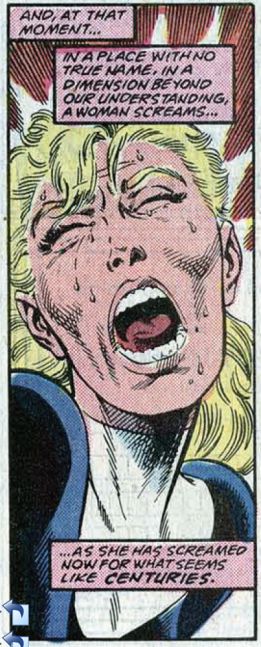
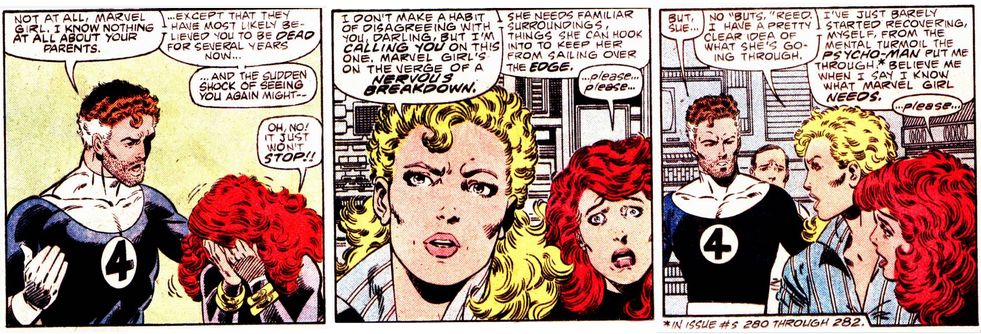
For the rest, see the individual issue commentaries.
The Fantastic Four is a single continuous story: the story of how Susan beat her monsters, in five acts.
In act 5 Reed Richards finally puts his family first. He lets Ben (the one who represents monsters) take control. Ben's different approach leads to new insights and a healthier team. While Ben does not have Reed's skill with technology, he has a far greater skill: empathy. Ben is able to make use of everybody's different talents. He gains access to the Mole Man's dimensional portals, advanced laboratories in Project Pegasus, and endless alien worlds. Finally Reed returns, happy at last. His new relaxed mind is able to understand magic for the first time, and Ben is finally cured.
In act 5, the FF ceases to be a monster comic. The focus on mutual
respect and alliances (with Wakanda, Latveria, the Inhumans, the Mole
Man, the Comet Men, the shaper of worlds and others)
means that monsters will never again be a serious danger. Whatever
happens from now on, powerful friends will be there to help.
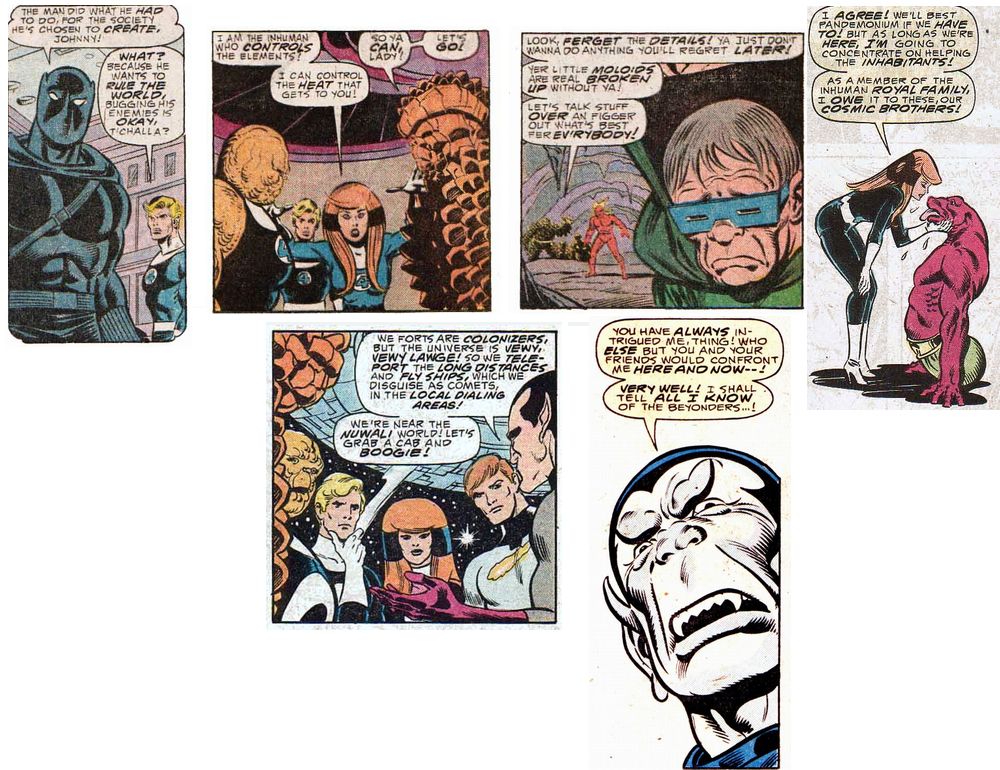
Susan's
methods have won. The story is over, and we are ready for a new and different story - Johnny's story.
The Franklinverse stories try to go back to the old days, trying t
recapture the excitement of the ays before act 5. But they faiol because
they are not monster comics. They are superhero comics pretending to be
monster comics and it doesn't work. To illustrate, recall the original
Galactus trilogy, and compare it to the same story retold for "Heroes Reborn":
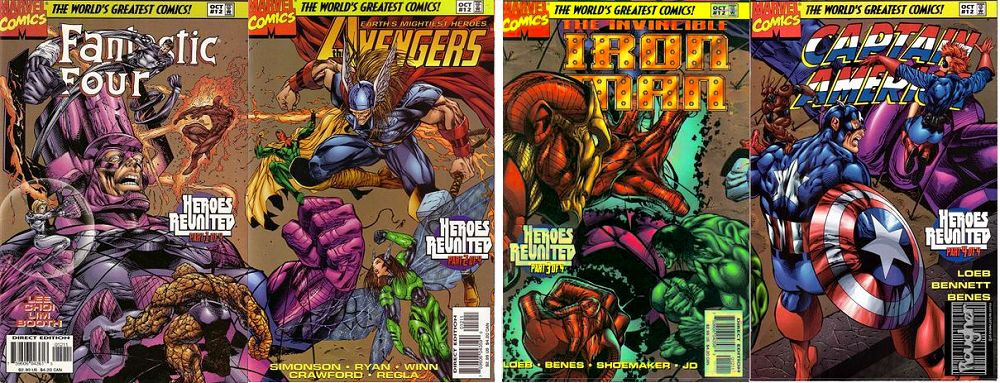
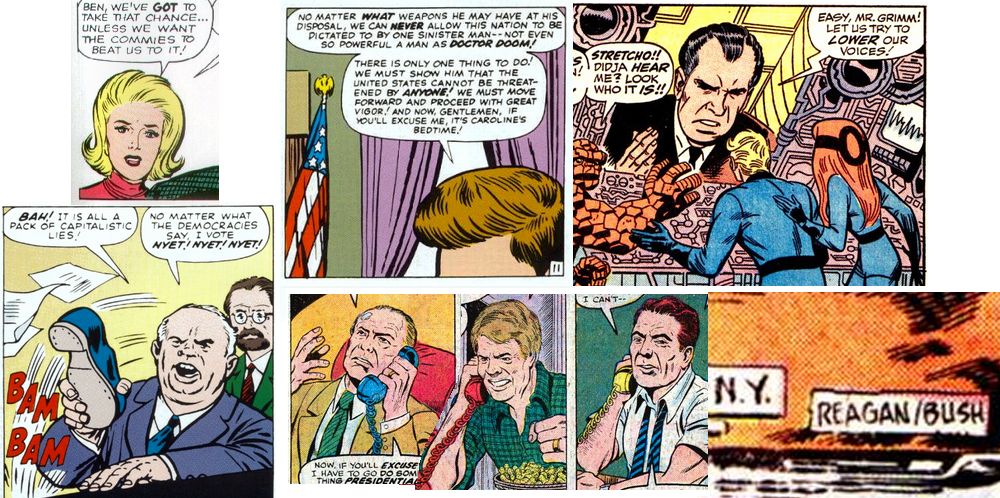
It is widely understood that monster comics and monster movies
represented cold war fears. The Invasion of the Body Snatchers (1956) is
really about the fear
off communists taking over. Godzilla (1954) is really about Japan's
fear of atomic radiation. The Day The Earth Stood Still (1951) is really
about the fear of nuclear destruction.
And the Fantastic Four is about all those things in the context of The
Space Race.
Fantastic Four issue 1 was plotted in April 1961, when the Russians put the first man in space. That is the theme of the origin story: America has to beat Russia into space!
The first year's stories (until issue 7 they were published every two months) showed the team as lost and unsure. But 1962 brought direction: Kennedy said "we choose to go to the moon" and the FF did just that, in issue 13, racing the Russian, "the Red Ghost".
1962 also saw the rise of computers, as reflected in FF15 and the Mad Thinker. The Thinker combined information from different sources, just like the Internet, invented in that same year:"The
first recorded description of the social interactions that could be
enabled through networking was a series of memos written by J.C.R.
Licklider of MIT in August 1962 discussing his "Galactic Network"
concept. He envisioned a globally interconnected set of computers
through which everyone could quickly access data and programs from any
site. In spirit, the concept was very much like the Internet of today.
Licklider was the first head of the computer research program at DARPA,4
starting in October 1962." (source)
Every year reflected the hopes and fears of America at that time. And
the biggest themes were shown as monsters: nuclear destruction was
represented by Galactus; marriage was represented by Dragon Man (see the
notes to F 35); drug taking was represented by Psycho Man;
environmental damage was represented by the yetis with their ice ray;
mankind's need for direction was represented by the Shaper of Worlds;
the
battle of the sexes war represented by Thundra and Makhizmo; our
personal weaknesses were represented by the team fighting numerous
doppelgangers; and so on. Finally, the dangers of the arms race were
represented by the tearing open of the negative zone, allowing Blastaar
(the monster who represented bombs) and Annihilus (the monster who
represented killing) to threaten the whole universe.
The answer to the cold war is in the end not bigger and bigger weapons, but communication. Reed had to learn to listen to his family and friends, and close the negative portal forever. And in the real world, America and Russia had to begin working together. And so it was that inn 1989 the Berlin Wall came down, the Cold War was over, and Fantastic Four continuity ended with issue 333.
After 1989 there was nothing left to say about the Cold War. The
Fantastic Four comic looked backwards instead of forwards, and gradually
faded into obscurity. Now we are left with just memories of when the
Fantastic Four was The World's Greatest Comic Magazine.
Sue is more intelligent than Reed. That is the bottom line.
Intelligence is a measure of problem solving. Reed cannot solve the
problem of survival. Sue can.
The opposite of violence is not passivity, but intelligence
To the unintelligent, there is either violence or nothing. But to the
intelligent, there is either violence or thought. And since pure
violence leads to rapid destruction, what survives is less intelligence
versus more intelligence. Reed's idea is less intelligent:build the
ultimate weapon. Sue's idea is more intelligent: to build networks (of
Inhumans, Watchers, Dragon Riders, etc). These networks can withstand
and survive anything. And whatever weapon Reed devises, there is a good
chance these wider networks have already devised it then moved on to
something better. So Reed' method is never the more intelligent one, and
Sue's method always is.
Big intelligence versus small intelligence
On the surface, Reed looks more intelligent; because he can solve
scientific problems. but science is a method of simplifying reality:
remove as many variables as possible then compare measurements, and you
then find out how a tiny part of reality works. This allows us to create
tools that deal with small parts of reality. but tools are only as good
as those who use them. The same science that creates unlimited energy
can create unlimited destruction. The same science that lets you destroy
the other guy also lets the other guy destroy you. The same science
that lets you network into more powerful groups also lets more powerful
groups network you, turning you into a tool for them. In short, Reed's
solutions never work for very long: the bad guys always come back.
Emotion versus calculation
Sue is more intelligent because in every case she sees the bigger
picture:Reed sees the immediate threat, but Sue intuitively sees the
values behind the threat: the emotional angle. The bigger picture has to be encapsulated in emotions, not logic, because there are too many variabnles for the brain to compute. Emotions are simply summaries of a lifetime's experience, where it is not possible to stop and evaluate every cause. We evolved emotion for a reason! An emotion encapsulates orders of magnitude more data than a direct reading ever could.
Individual versus colony
Reed's idea of survival does not extend beyond the individual or the
family. If he or his family might die then he feels he has to act. But
Sue had a better understanding of identity: identity is values. We are
values. Our bodies do not matter, our values do. Sue will sometimes
hesitate, even if it means putting her or her family at immediate risk,
in order to follow her values. That is, she puts values ahead of the
physical body. Because if the body dies but values remain then we win.
But if the body survies but values die then we lose. All of Sue's
efforts are in networking: spreading our values as widely as possible.
The survival of genes
Biologists understand this on a genetic level. A species depends on the
survival of its genes. It is often worth sacrificing your own life so
that your family's genes survive.And sometimes worth sacrificing a whole
section of your colony so the wider colony survives. Sue's colony is
everyone who shares her values: from the Watcher to the Inhumans to the
Dragon Riders, a colony spanning all time and space. Each part is
willing to sacrifice itself for the rest, and the colony is so big that
defeat becomes impossible. In contrast, Reed's colony does not extend
beyond his immediate friends, and that colony is so weak (on a galactic
scale) that its eventual destruction is almost certain.
That example featured genes. Identity is not in genes but memes, which can spread even farther and more quickly. But the principle holds.
Men v women
All of this is encapsulated by the battle between men and women. On an
evolutionary scale, men are expendable. A single man can produce
thousands of offspring, so very few offspring are needed. But those
thousands of offspring require hundred or thousands of mothers, who do
most of the raising. So the women matter. This means that the society
that survives is the one where men take great risks: occasionally men
will accidentally discover some big advantage, and the women can then
follow. Usually the men will fail, but they are expendable. Men are how
women experiment. From an evolutionary perspective, men are just tools,
like dumb rocks.
Wisdom versus knowledge
Big intelligence is called wisdom. it is a focus on the bigger, abstract
principles. Above all, it recognises that things must be taken slow.
Slow, as in a lifetime for raising a child, versus one minute to
conceive one. It recognises that the correct solution will take a long
time to find, and might require our own sacrifice. So wisdom is not
worried about impending death, whereas knowledge panics. Wisdom knows
that "I might be wrong" whereas knowledge says "on the basis of the
available data this is the best choice". So you can tell a wise person
by their desire to take things slow, to see the other person's point of
view, to be reluctant to not force their will on others, even when that
risks their own deaths, And above all, to network. the brain is a
network, and the more that a brain can network with other brains, the
more intelligent it can be.
The Dunning-Kruger effect
The real problem is that those who are not intelligent lack the
intelligence to realise it. Hence they see wisdom as foolishness,
because it might get the person killed. They cannot understand life at
the group level, only at the individual level. They see the alternative
to violence as doing nothing, because they do not understand how
intelligence works: to them there is just kill or be killed. They do not
understand evolution: they do not see how evolution has selected for
low IQ, high emotion people just as much as it has selected for high IQ,
low emotion people. They do not recognise scale: that given the vast
size of the universe it is group survival that matters, not individual
survival. They do not understand abstraction: that consciousness must
reside in values, not in the body.
The Dunning-Kruger effect is the observation that people with low
expertise tend to over estimate their expertise. It is a subset of the
wider principle that "empty vessels make the most noise". In the
Fantastic Four, Reed Richards makes the most noise. His brain is the
most full of short term data, but the most empty of the long term data
that matters most.
Socrates and Sue
In the words of Socrates, whom the Delphic Oracle called the wisest of
all philosophers, "true wisdom is to know that you know nothing".
Socrates was not arguing that wisdom and ignorance are the same. He was
arguing for extreme caution, for the testing of everything, for taking
things very, very slow. He would question everything, so much that he
never rushed into any decision or claimed any understanding The only
thing he felt confident in saying is that we should follow what feel
like our higher, self sacrificing, noble values. Even though he, the
most critical of thinkers, could not prove why.
Reed Richards, in trying to solve his problems through war machines,
is like the anti-Socrates:the warlords who constantly arise and try to
ensure their group's supremacy through violence. But Sue is like
Socrates: she appears weak, at the mercy of foolish enemies, but
ultimately will win even if she dies. Socrates was forced to drink hemlock because he noted that Sparta, his people's enemy, had better values at the time (Athens was becoming more corrupt). But despite the death of his body,
Socrates lives on through his values. Wise people recognise and admire
Socrates and Sue for being right, whereas the foolish are only concerned
with winning at any cost.